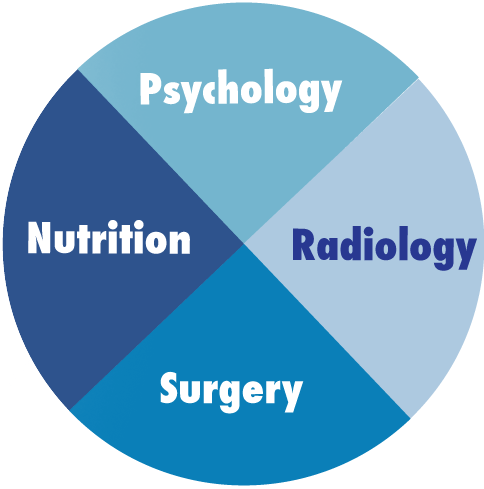 |  |
| See how our team connects in diagnosing and treating neuroendocrine cancer. |
| Surgery | Radiology |
| Psychology | Nutrition |
-
Typically, neuroendocrine tumors (NETs) occur in either the lung or the gastrointestinal tract. These tumors, also known as carcinoids, are formed when hormone-producing cells, needed to maintain normal function for breathing or digestion, grow abnormally. Classic carcinoids can cause a variety of uncomfortable symptoms, including flushing, diarrhea and abdominal pain.
But NETs can also occur in the pancreas. Pancreatic NETs come in several forms, depending on the hormone they secrete. The most common are gastrin, insulin, glucagon and vasoactive intestinal peptide. These hormonally active tumors cause symptoms ranging from sugar issues, rashes, severe diarrhea and ulcers. However, the most common type of pancreatic NET doesn’t produce a hormonal syndrome. So, they may cause more subtle symptoms or none at all.
-
Neuroendocrine tumors are a relatively new term encompassing lots of different types of tumors. In the past, they were all known as carcinoids or APUDomas, which can lead to a lot of confusion. Luckily, we now use a more standard terminology, which helps physicians discuss these cases.
And while the most common NETs occur in the lung, intestinal tract or pancreas, even more rare NETs can be found in the thyroid, thymus and elsewhere in the body. It’s important to remember that not all NETs behave or should be treated the same.
-
Carcinoids and other NETs are uncommon tumors that are extremely complicated. Because, NETs are not as common as breast, prostate, lung or colon cancers, many physicians and surgeons may only see one or two NETs in their whole careers. Therefore, it can be difficult to sort through the different types of NETs and know how they should be treated.
-
Carcinoid tumors in the small intestines are formed when cells that produce hormones needed to maintain normal function for digestion grow abnormally. These cells produce a hormone called serotonin. Unlike other fast-growing tumors, carcinoids can stay small and remain dormant for many years. Unfortunately, they usually aren’t diagnosed until they’ve already spread into lymph nodes or into the liver. Sometimes, they spread very far into the bones or elsewhere in the body.
-
We employ many different diagnostic tools and tests to uncover and confirm NETs. They range from blood and urine tests, to scans to endoscopy. The blood tests most often used are called “markers,” the most common of which is Chromogranin A. This test helps determine how many tumors are present.
Based on the type of tumor present, a variety of tests are available. In carcinoids, we often use a urine test called 5-HIAA. Another very valuable test is the CT scan. It takes high resolution images of the inside of one’s body and can frequently find tumors. MRI is also now being used more because it provides excellent images and reduces the amount of radiation exposure. Endoscopy allows us to look directly at tumors in the stomach, small intestine, pancreas and colon, which can then be confirmed by biopsy. And, finally, ultrasound technology is also used to examine certain NETs.
-
This exciting new technology may provide the highest resolution and sensitivity in locating NETs. Although it has been used as a diagnostic tool abroad, Vanderbilt is the only neuroendocrine center in the U.S. with FDA approval to study this tracer in a clinical trial. How it works: the radioactive tracer is injected into the blood stream, where it attaches itself directly to the tumors. By effectively shining a light on the tumors in the area, this tracer enables traditional PET and CT scans can more easily locate them.
-
The Octreoscan is current gold standard for scanning and locating neuroendocrine tumors. This powerful test is specifically designed to detect NETs. In some situations, it can find tumors that were previously undetected in traditional CT or MRI scans. It can also be used to confirm that tumors seen on CT or MRI are actually neuroendocrine tumors.
-
Because carcinoids are slow growing, a combination of surgery and medical therapies is a good treatment plan for many NETs. In the past, these often elusive tumors were discovered only after a patient was scanned for another illness. But with dramatically improved radiological imaging techniques making its way to the U.S., we can now find and remove many NETs earlier than ever before.